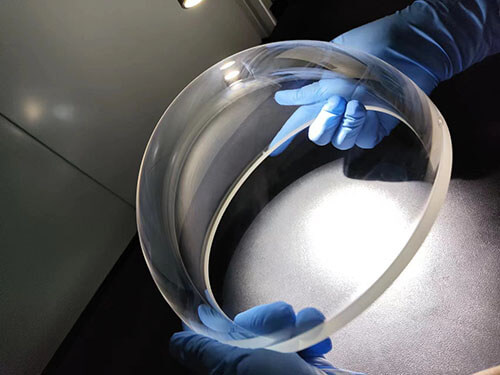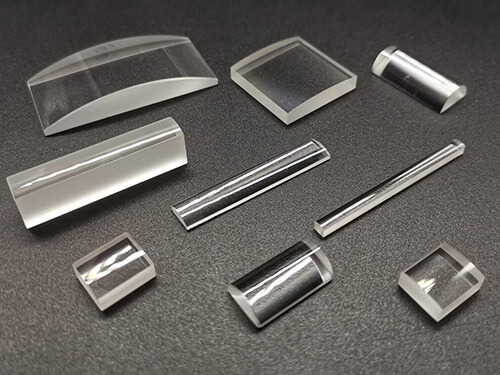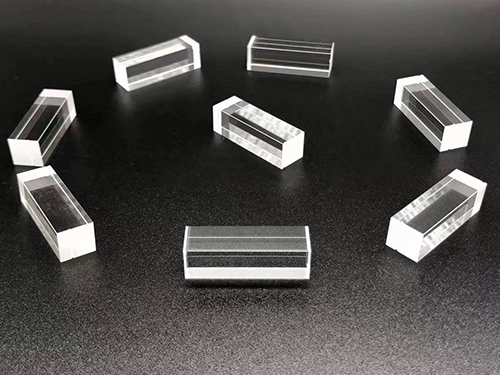Precision Quality Custom Sapphire Glass Manufacturer At Competitive Price
Need custom sapphire glass parts for your OEM project? When sourcing your custom sapphire crystal parts, you need a reliable and experienced manufacturer.
Our factory has years of experience producing top-quality sapphire window parts for clients around the world. We can provide high-quality sapphire parts that meet your exact specifications.
Our OEM custom sapphire glass parts include custom sapphire glass windows, sapphire IPL light guides, sapphire prisms, custom sapphire domes, sapphire hemispherical domes, sapphire hyper-hemispherical domes, kerfs sapphire domes, spherical sapphire domes, aspheric sapphire domes, sapphire domes (Sapphire fairing radome), U-shape sapphire domes, conformal sapphire domes, and special–shaped sapphire hyper-hemisphere dome, sapphire cones, sapphire rods, sapphire tapered rods, micro sapphire rods, sapphire wedges, round sapphire windows, rectangular sapphire windows, sapphire piston/plunger rods, sapphire T-step windows, large sapphire windows, custom-shaped sapphire windows, etc.
Contact us now to request an instant free quote.
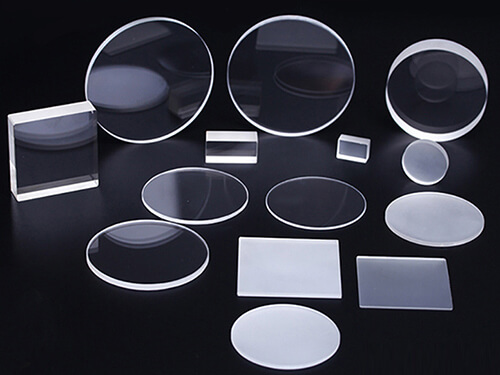
Our custom sapphire glass parts Capabilities
As a lead custom sapphire glass factory, we produce top-quality custom sapphire glass products that are not only precise and durable but also cost-effective. Our advanced technology ensures each sapphire crystal part can meet the most stringent standards.
Our custom services are designed to meet the specific needs of our clients. We work closely with each customer to understand their unique requirements and deliver products that meet their specifications.
We offer a range of customization options, including size, shape, color, and finish.
Our goal is to build long-term relationships with our customers based on trust and mutual respect. Win-win cooperation is what we looking for.
We pride ourselves on offering competitive prices that are unmatched in the industry. We can help you to save 60%-80% on purchasing costs for your custom sapphire projects.
Contact us and let us save time and cost for your custom sapphire glass crystal parts.
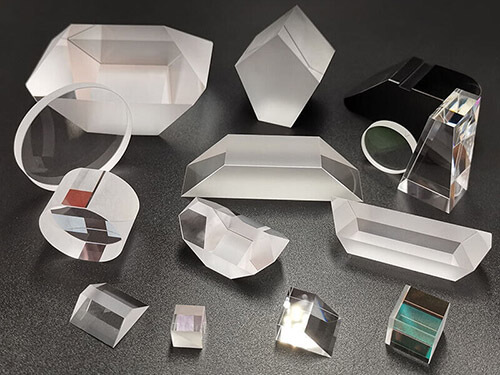
The Advantage Of HY's Custom Sapphire Glass Service
With years of experience in custom sapphire glass parts manufacturing, our factory has the expertise and technology to produce high-quality sapphire window parts. We specialize in producing high-quality sapphire glass lenses that meet your specific needs. The advantages of our custom sapphire crystal glass are as below:
- NO MOQ
- Competitive price
- Strictly quality control
- Easy online ordering
- Support Sample Service
- Satisfaction guaranteed
- Various processing techniques
- Custom cut exactly to your request
- Various coating services for your choice
- Production time as fast as 7 business days
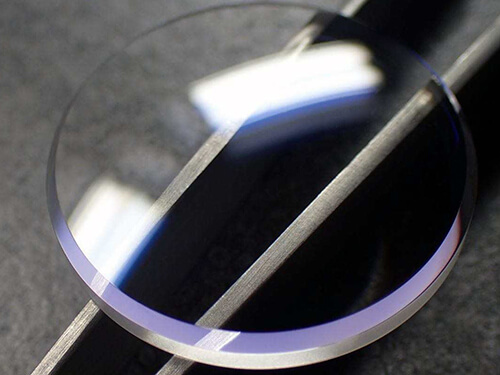
Custom Sapphire Glass Parts We Can Manufacture
- Sapphire Windows
- Lens Cover Glass
- Beauty Equipment
- Sapphire Watch Cover
- Protective Observation Window
- Observation Port For Cryogenic Experiments
- Sapphire Lenses
- Infrared Sight
- Optical Prism
- Infrared Optical Window
- Instrumentation Protection Window
- Laboratory Reactor Sapphire Window
- Optical Glass
- Camera Lens
- Sapphire Optical Window
- Night Vision Camera
- Petroleum Instrument Window
- Night Vision Infrared and Far Infrared Scopes
- Sapphire Block
- Optical Element
- IR Window
- Optical Window
- Light Guide Sapphire Block
- Sapphire high temperature and high-pressure window
What are the advantages of custom sapphire glass parts?
Durability: Sapphire crystal glass is extremely hard and durable, making it resistant to scratches and damage from impacts.
Clarity: Custom sapphire crystal glass parts offer exceptional clarity, allowing for maximum light transmission and minimal distortion.
Heat resistance: Sapphire crystal glass can withstand high temperatures, making it suitable for use in extreme environments.
Chemical resistance: Sapphire crystal glass is resistant to most chemicals, making it suitable for use in harsh chemical environments.
Abrasion resistance: Sapphire crystal glass is highly resistant to abrasion, making it ideal for use in applications where friction and wear are a concern.
Corrosion resistance: Sapphire crystal glass is resistant to corrosion, making it suitable for use in applications where exposure to corrosive substances is a concern.
Dimensional stability: Sapphire crystal glass maintains its shape and dimensions under extreme temperature and pressure conditions, making it ideal for use in precision instruments.
Optical properties: Custom sapphire crystal glass parts have excellent optical properties, making them ideal for use in optical components such as lenses and prisms.
Biocompatibility: Sapphire crystal glass is biocompatible, making it suitable for use in medical implants and other medical applications.
Aesthetic appeal: Custom sapphire crystal glass parts offer a high-end, luxurious look and feel, making them ideal for use in high-end consumer products such as watches and jewelry.
Customizability: Custom sapphire crystal glass parts can be designed to meet the specific needs of a particular application, allowing for a high degree of customization and flexibility.
Applications of Custom Sapphire Crystal Glass Parts?
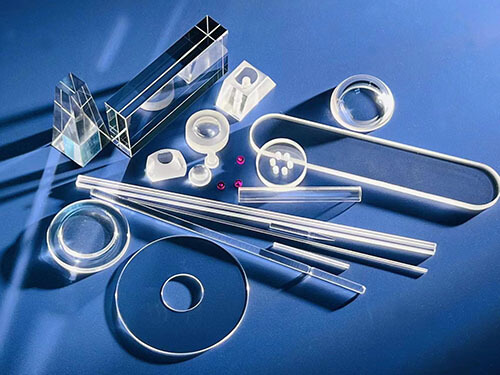
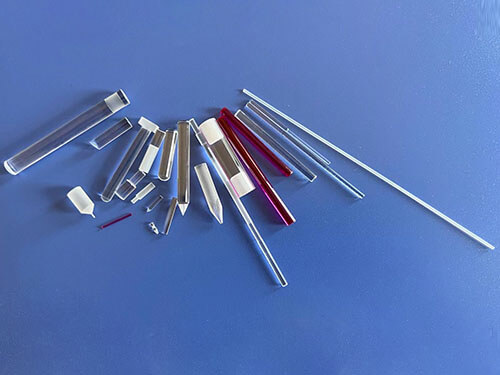
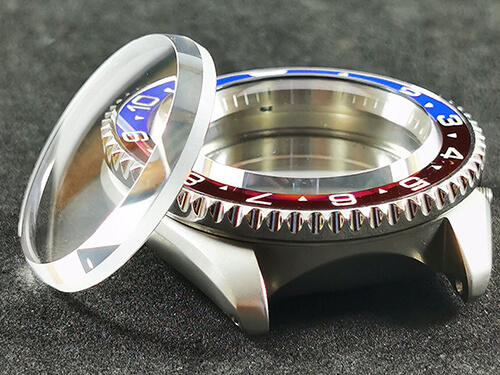
Custom sapphire glass parts have a wide range of applications due to their exceptional properties such as high hardness, scratch resistance, chemical resistance, and excellent optical clarity. Here are some common applications of custom sapphire glass parts:
1. Watch crystals: Sapphire glass is commonly used in high-end watches due to its scratch-resistant and durable nature.
2. Optics: Sapphire is used in optics, such as lenses and windows, due to its high refractive index and excellent transmission of light.
3. Consumer electronics: Sapphire is used in smartphones and other consumer electronics as a protective cover for camera lenses and touchscreens.
4. Industrial windows: Sapphire glass is used as windows in industrial equipment due to its resistance to high temperatures, pressure, and chemicals.
5. Aerospace components: Sapphire glass is used in aerospace applications, such as missile domes and cockpit windows, due to its high strength and durability.
6. Medical devices: Sapphire is used in medical devices such as endoscopes, surgical instruments, hair implants transplant gem knives, and dental drills due to its biocompatibility and resistance to corrosion.
7. High-pressure sensors: Sapphire glass can withstand high pressures and is used in high-pressure sensors used in industries such as oil and gas exploration.
8. Semiconductor industry: Sapphire is used in the semiconductor industry as a substrate for the growth of gallium nitride (GaN) for use in LED lighting and other electronic applications.
Custom sapphire glass parts are used in a wide range of applications where high strength, durability, and optical clarity are required.
Why More Than 1500+ Clients ♥️ HY
Save Cost
We will reduce your 60%-80% purchase cost by investing in high-precision sapphire glass machining machines, improving production efficiency, and purchasing raw materials in bulk.
Ultra Quality
Our QC department combines the most advanced technology and experienced professionals to ensure strict inspection and 100% compliance with your requirements and specifications.
Precision Machining
Our tolerances are between +/-0.05~0.1 (mm) to meet your accuracy requirements for your custom sapphire crystal parts. Our ultra-modern machining technology can meet your tight request for sapphire laser cutting parts.
Expertise Engineer Team
Our full-experience engineering team provides technical consultation, pre-review of drawings, structural analysis, risk assessment, design suggestions, and cost analysis to ensure accuracy and save the cost for you.
Fast Delivery
Samples time can be as fast as 3 business days. Mass production time can be as fast as 5 business days. Our advanced equipment and streamlined production process will meet your urgent time request.
No MOQ
You won't face MOQ problems with us. We never require a minimum order volume or minimum dollar value. We'll help you to achieve your goal even if you only need 1 pc custom sapphire lens part.
Cilents & Feedbacks






Start Your Custom Sapphire Glass Parts Project With Us Now
We are a reliable and high-quality custom sapphire glass parts supplier that provides precision sapphire glass parts at competitive prices. Our OEM custom sapphire glass parts include custom sapphire glass windows, sapphire IPL light guides, sapphire prisms, custom sapphire domes, sapphire hemispherical domes, sapphire hyper-hemispherical domes, kerfs sapphire domes, spherical sapphire domes, aspheric sapphire domes, sapphire domes (Sapphire fairing radome), U-shape sapphire domes, conformal sapphire domes, and special–shaped sapphire hyper-hemisphere dome, sapphire cones, sapphire rods, sapphire tapered rods, micro sapphire rods, sapphire wedges, round sapphire windows, rectangular sapphire windows, sapphire piston/plunger rods, sapphire T-step windows, large sapphire windows, custom-shaped sapphire windows, etc. Start our story now and let us save you time and cost.
More Knowledge Of Custom Sapphire Glass Service
Table of Contents
1. What is sapphire glass?
Sapphire glass is a type of synthetic sapphire that is used as a transparent material in various applications.
It is made by growing a single crystal of aluminum oxide (Al2O3) and is known for its exceptional hardness, scratch resistance, and thermal stability.
It is a very hard, transparent material that is second only to diamonds on the Mohs hardness scale.
Sapphire glass is commonly used in high-end electronic devices such as smartphone screens, watch faces, and LED lights, as well as in industrial applications such as optics, semiconductors, and aerospace components.
These properties make sapphire glass a popular choice for applications that require high durability and transparency.
2. What are the properties of sapphire glass?
Sapphire glass, also known as synthetic sapphire or aluminum oxide (Al2O3), is a durable and high-performance material that possesses several notable properties. Here’s a description of various properties of sapphire glass:
Chemical Properties:
Sapphire glass is composed of aluminum oxide (Al2O3), which is a chemically inert material. It is highly resistant to attack by acids and alkalis, making it corrosion-resistant.
Thermal Properties:
Sapphire glass has a high melting point of approximately 2040°C, which makes it suitable for high-temperature applications.
It has a low coefficient of thermal expansion, which means it does not expand or contract significantly with temperature changes, making it dimensionally stable in various environments.
Optical Properties:
Sapphire glass is transparent in the ultraviolet (UV), visible, and near-infrared (NIR) regions of the electromagnetic spectrum.
It has a high refractive index, ranging from 1.75 to 1.77, which results in excellent light transmission and optical clarity.
Sapphire glass has a low absorption coefficient, making it suitable for optical applications where minimal light loss is desired.
Mechanical Properties:
Sapphire glass is an extremely hard material, with a Mohs hardness of 9, second only to diamond. This makes it highly scratch-resistant and durable.
It has high tensile strength, typically ranging from 200 to 1000 MPa, which makes it resistant to fracture and breakage.
Sapphire glass also has high flexural strength, typically ranging from 300 to 600 MPa, which makes it resistant to bending and deformation.
Electrical Properties:
Sapphire glass is an insulator, meaning it has low electrical conductivity. It is commonly used in electrical insulation applications.
It exhibits piezoelectric properties, which means it can generate an electric charge in response to mechanical stress, and vice versa. This property makes it useful in sensors and transducers.
Physical Properties:
Sapphire glass has a high density, typically ranging from 3.95 to 4.10 g/cm^3, which gives it a solid and heavy feel.
It has a transparent or translucent appearance, depending on the purity and processing of the material.
Sapphire glass is available in various shapes and sizes, ranging from small components to large windows or substrates.
Sapphire glass is a highly desirable material due to its excellent combination of properties, including its chemical inertness, high melting point, transparency, hardness, strength, and electrical properties. It finds applications in various fields, including optics, electronics, aerospace, defense, medical devices, and more.
3. What's the Advantage of sapphire glass?
Sapphire glass, also known as synthetic sapphire or sapphire crystal, offers several advantages over other types of glass or transparent materials. Some of the key advantages of sapphire glass include:
Exceptional Hardness and Scratch Resistance:
Sapphire glass is one of the hardest known materials, with a hardness of 9 on the Mohs scale, which is just below that of a diamond. This makes sapphire glass highly scratch resistant, ensuring that it maintains its clarity and transparency even under harsh conditions or frequent use. This property makes sapphire glass ideal for applications where scratch resistance is crucial, such as in luxury watches, camera lenses, and optical windows.
High Optical Clarity and Transparency:
Sapphire glass is highly transparent across a wide wavelength range, from UV to NIR, making it ideal for optical applications that require excellent clarity and light transmission. Sapphire glass has a high refractive index, which makes it suitable for optical components such as lenses, windows, and covers that require precise light handling and minimal distortion.
Durability and Longevity:
Due to its exceptional hardness and scratch resistance, sapphire glass is highly durable and long-lasting. It is resistant to wear and tear, abrasion, and impact, making it suitable for applications that require a robust and reliable material. Sapphire glass is often used in demanding environments such as aerospace, defense, and high-end watches, where durability and longevity are critical.
Thermal Stability and High-Temperature Resistance:
Sapphire glass has a low coefficient of thermal expansion (CTE) and high thermal conductivity, which means it can withstand a wide temperature range without significant dimensional changes or performance degradation. This makes sapphire glass suitable for high-temperature applications, such as in LED substrates, laser windows, and high-power electronics, where thermal stability is important.
Chemical Resistance:
Sapphire glass is highly resistant to chemicals, acids, and alkalis, which makes it suitable for applications that involve exposure to harsh chemicals or corrosive environments. Sapphire glass is commonly used in chemical sensors, analytical instruments, and industrial processes where chemical resistance is required.
High-End Aesthetic Appeal:
Sapphire glass is also valued for its luxurious and high-end aesthetic appearance. Its crystal-clear transparency, hardness, and scratch resistance make it a popular choice for premium watches, smartphones, and other luxury consumer products.
Versatility:
Sapphire glass can be fabricated into various shapes and sizes, making it versatile for a wide range of applications. It can be used as windows, lenses, covers, substrates, and other optical or protective components in various industries, including aerospace, defense, electronics, optics, and consumer goods.
The advantages of sapphire glass include its exceptional hardness, scratch resistance, high optical clarity, durability, thermal stability, chemical resistance, high-temperature resistance, aesthetic appeal, and versatility. These properties make sapphire glass a preferred material for many high-performance applications where its unique characteristics are highly desirable.
4. What's the Disadvantage of sapphire glass?
While sapphire glass offers many advantages, it also has some disadvantages that may limit its use in certain applications. Some of the main disadvantages of sapphire glass include:
Cost:
Sapphire glass is more expensive to produce compared to other types of glass or transparent materials. The process of growing synthetic sapphire crystals is complex and time-consuming, involving high temperatures, specialized equipment, and precise control of growth conditions, which adds to the production cost. As a result, sapphire glass tends to be more expensive than traditional glass or other transparent materials, making it less cost-effective for some applications.
Brittle Nature:
Despite its exceptional hardness, sapphire glass is relatively brittle compared to other materials like tempered glass. Sapphire glass can be susceptible to cracking or chipping under certain conditions, especially when subjected to significant impact or stress. This brittleness can make sapphire glass more prone to damage in certain applications that involve high-impact forces or mechanical stresses.
Difficulties in Processing:
Sapphire glass is more challenging to process compared to other materials. It is a crystalline material that requires specialized cutting, grinding, and polishing techniques, which can be more time-consuming and costly. Additionally, sapphire glass is difficult to bond or join, which can limit its use in certain applications that require bonding or sealing.
Limited Size and Thickness:
The size and thickness of sapphire glass are relatively limited due to the challenges in growing large and thick sapphire crystals. Sapphire glass is typically available in smaller sizes and thinner thicknesses compared to traditional glass, which may not be suitable for certain applications that require larger or thicker glass components.
Weight:
Sapphire glass is denser than traditional glass, which means it can be heavier for a given size and thickness. This can be a disadvantage in weight-sensitive applications or when designing lightweight devices, where the weight of sapphire glass may need to be taken into consideration.
More Energy-Intensive Production:
The production of synthetic sapphire crystals used for sapphire glass requires high temperatures and energy-intensive processes, which can contribute to higher energy consumption and environmental impact compared to other materials. This may be a concern for some environmentally conscious applications or industries.
Reflectivity without Anti-Reflective (AR) Coating:
Sapphire glass has a relatively high refractive index, which can result in significant reflection from its surface without proper anti-reflective (AR) coating. This can cause unwanted reflections or glare in certain applications, such as displays or optical lenses, which may require additional AR coating to mitigate the issue.
While sapphire glass offers many advantages, it also has some disadvantages, including higher cost, brittleness, difficulties in processing, limited size and thickness, weight, more energy-intensive production, and reflectivity without AR coating. These limitations may need to be considered when evaluating the suitability of sapphire glass for specific applications, and alternative materials may be preferred depending on the requirements and constraints of the application.
5. What makes sapphire glass expensive?
Sapphire glass is a premium material known for its exceptional hardness, durability, and scratch resistance. There are several factors that contribute to the high cost of sapphire glass, including:
Material cost:
Sapphire is a crystalline form of aluminum oxide (Al2O3) that is carefully grown in laboratories using specialized methods such as the Verneuil process or the Kyropoulos method. The process of growing sapphire crystals is complex and time-consuming, requiring high temperatures, controlled environments, and specialized equipment. The raw material cost for sapphire is relatively high compared to other types of glass, making it more expensive.
High melting point:
Sapphire has a very high melting point of around 2040°C (3704°F), which requires specialized furnaces and energy-intensive processes for melting and shaping. The high melting point of sapphire makes the manufacturing process more challenging and costly compared to other types of glass.
Difficult cutting and shaping:
Sapphire is one of the hardest known materials, with a Mohs hardness of 9, which is just below that of a diamond. This makes cutting, shaping, and polishing sapphire glass extremely difficult and time-consuming, requiring specialized tools and expertise. The high cost of cutting and shaping sapphire glass adds to its overall expense.
Low yield rates:
The production of sapphire glass involves a significant amount of waste due to the difficulty in cutting and shaping the material, resulting in low yield rates. This means that a substantial amount of sapphire material may be wasted during the manufacturing process, further driving up the cost.
Demand and availability:
Sapphire glass is used in a wide range of high-end applications, such as premium watches, camera lenses, and high-performance windows for aerospace and defense applications. The demand for sapphire glass in these industries is relatively niche, and the availability of high-quality sapphire material may be limited, leading to higher prices.
Specialized applications:
Sapphire glass is often used in specialized applications where its unique properties, such as high strength, scratch resistance, and optical clarity, are required. These applications, such as luxury watches or high-end smartphones, typically demand a premium price due to the added value that sapphire glass brings.
The high cost of sapphire glass can be attributed to factors such as the cost of raw materials, the challenging manufacturing processes, low yield rates, limited availability, and demand for specialized applications. All these factors contribute to the premium price tag associated with sapphire glass.
6. How is sapphire glass made?
Sapphire glass is made using a process called the Verneuil process, which involves the following steps:
Raw materials:
The main raw materials used in sapphire glass production are aluminum oxide (Al2O3), also known as alumina, and a small amount of a crystallization promoter such as chromium oxide (Cr2O3) or titanium oxide (TiO2).
Melting:
The raw materials are melted in a high-temperature furnace, usually using an oxyhydrogen flame. The temperature is carefully controlled to ensure complete melting and homogeneity of the molten material.
Seed crystal:
A small sapphire crystal, also known as a seed crystal, is dipped into the molten material and then slowly withdrawn while rotating. As the molten material solidifies, it crystallizes onto the seed crystal and starts to grow in a cylindrical shape.
Pulling process:
The seed crystal is then slowly pulled upward, allowing the sapphire crystal to grow vertically. The rate of pulling is carefully controlled to ensure uniform growth and desired crystal quality. The crystal continues to grow as long as the molten material is available.
Cooling and annealing:
Once the desired size of the sapphire crystal is achieved, it is slowly cooled to room temperature to relieve internal stress and anneal the crystal. This helps to improve the mechanical strength and optical properties of the sapphire glass.
Cutting and polishing:
After annealing, the sapphire crystal is cut into desired shapes, such as sheets or wafers, using diamond saws or laser cutting techniques. The cut pieces are then polished to achieve the final desired thickness, smoothness, and optical clarity of the sapphire glass.
Optional treatments:
Depending on the specific application, the sapphire glass may undergo additional treatments such as chemical strengthening or surface coatings to further enhance its properties, such as scratch resistance or anti-reflective properties.
The Verneuil process is a well-established and widely used method for producing sapphire glass with high quality and large sizes, although it can be time-consuming and energy-intensive. Other methods, such as the Kyropoulos method and the heat exchange method, are also used for sapphire crystal growth, but they are less common compared to the Verneuil process.
7. Types of sapphire glass?
There are two main types of sapphire glass:
Monocrystalline Sapphire:
This type of sapphire glass is made from a single crystal of aluminum oxide, which is grown in a laboratory using a process known as the Verneuil method. Monocrystalline sapphire is extremely hard and scratch-resistant, making it ideal for use in high-end watches, smartphone screens, and other electronic devices.
Polycrystalline Sapphire:
This type of sapphire glass is made by fusing small sapphire crystals together using heat and pressure. Polycrystalline sapphire is not as hard as monocrystalline sapphire, but it is still very durable and scratch-resistant. It is often used in applications where high optical clarity is required, such as camera lenses and medical equipment.
Both types of sapphire glass have excellent optical properties, including high light transmission and low light dispersion, which makes them ideal for use in lenses and other optical components.
8. Are sapphire crystals reflective?
Sapphire crystals, which are made of aluminum oxide (Al2O3) and are commonly used as a gemstone or in industrial applications, can exhibit reflective properties. However, their reflectivity depends on several factors, including the surface finish, the incident angle of light, and the wavelength of light.
In general, sapphire crystals are known to have a relatively high refractive index, which means that they can bend and slow down light passing through them, causing light to reflect off their surfaces. This property gives sapphire crystals a characteristic luster and brilliance, which is often used in gemstone jewelry. However, sapphire crystals can also be transparent, allowing light to pass through them without significant reflection.
The reflectivity of sapphire crystals can also vary depending on the surface finish. If the surface of a sapphire crystal is highly polished and smooth, it can exhibit higher reflectivity, whereas a rough or textured surface may scatter light, resulting in lower reflectivity.
Additionally, the reflectivity of sapphire crystals can also depend on the incident angle of light. When light strikes the surface of a sapphire crystal at a specific angle called the critical angle, total internal reflection can occur, causing the light to bounce back and reflect off the surface with very little loss of intensity. This phenomenon is often exploited in optical applications, such as in sapphire windows for high-pressure chambers or optical lenses.
Finally, the reflectivity of sapphire crystals can also depend on the wavelength of light. Sapphire crystals can exhibit different levels of reflectivity at different wavelengths, with some wavelengths being more strongly reflected than others. This property can be utilized in various optical and spectroscopic applications.
Sapphire crystals can exhibit reflective properties, but the level of reflectivity depends on various factors such as surface finish, the incident angle of light, and wavelength of light. Sapphire crystals can range from highly reflective to transparent, depending on these factors and how they are utilized in different applications.
9. Surface Quality of Sapphire?
The surface quality of sapphire is an important consideration when using this material for high-tech applications such as optical windows, watch faces, and smartphone screens. Sapphire is a very hard material, which means that it is resistant to scratches and other forms of wear and tear. However, the manufacturing process used to produce sapphire can affect the surface quality of the material.
The surface quality of sapphire is typically evaluated using a variety of techniques such as visual inspection, optical microscopy, and scanning electron microscopy. Surface roughness, which is the deviation of the surface from a perfectly smooth plane, is one important factor that can affect the quality of sapphire surfaces. Other factors include the presence of scratches, pits, or bubbles, as well as the overall transparency and homogeneity of the material.
To ensure the highest possible surface quality of sapphire, manufacturers typically use advanced polishing techniques to create a smooth and uniform surface. These techniques may include chemical mechanical polishing, diamond polishing, or laser polishing, depending on the specific application and requirements of the material.
The surface quality of sapphire is a critical factor in determining the performance and reliability of this material for high-tech applications.
10. Sapphire Crystal vs Mineral Crystal: What’s the Difference?
Sapphire crystal and mineral crystal are both materials commonly used in the manufacturing of watch crystals. Here are the key differences between the two:
Composition:
Sapphire crystal is made from aluminum oxide (Al2O3) in a crystalline form, while mineral crystal is typically made from hardened glass or synthetic materials such as tempered glass, acrylic, or plexiglass.
Hardness:
Sapphire crystal is one of the hardest known materials, with a hardness of 9 on the Mohs scale of mineral hardness, which is just below that of a diamond. In contrast, mineral crystal is not as hard and typically falls in the range of 5 to 7 on the Mohs scale.
Scratch Resistance:
Due to its exceptional hardness, sapphire crystal is highly resistant to scratches, making it highly durable and long-lasting. On the other hand, mineral crystal is less scratch resistant and can be more prone to scratching over time, especially when compared to sapphire crystal.
Clarity and Transparency:
Sapphire crystal is known for its high clarity and transparency, which provides excellent optical properties, such as a clear and crisp display of the watch dial. Mineral crystal can also offer good clarity, but it may have slightly lower transparency compared to sapphire crystal due to the nature of the materials used.
Cost:
Sapphire crystal is generally more expensive to produce compared to mineral crystal due to its higher manufacturing cost and the difficulty of working with such a hard material. Mineral crystal, being made from glass or other synthetic materials, is typically more cost-effective.
Applications:
Sapphire crystal is often used in luxury watches and high-end timepieces due to its premium properties, such as its scratch resistance and durability. Mineral crystal, on the other hand, is commonly used in more affordable watches and can also be found in other applications where scratch resistance and hardness may not be as critical.
In summary, while both sapphire crystal and mineral crystal are used in watchmaking, they differ in terms of composition, hardness, scratch resistance, clarity, cost, and applications. Sapphire crystal is known for its exceptional hardness, scratch resistance, and durability, but it can be more expensive. Mineral crystal, on the other hand, is generally more affordable but may be less scratch resistant and not as hard as sapphire crystal.
11. What's Sapphire Glass Laser Cutting Service?
Sapphire glass laser cutting is a service that involves using a laser beam to cut sapphire glass into precise shapes and sizes. Sapphire glass is a popular material for cutting due to its exceptional hardness, strength, and durability. It is commonly used in a variety of applications, including high-end electronics, aerospace, and medical devices.
The process of sapphire glass laser cutting begins with selecting a sapphire glass substrate of the appropriate thickness and size. The substrate is then placed onto a cutting bed, and the laser beam is focused onto the surface of the glass. The laser beam is guided along the desired cutting path by a computer-controlled system, which can precisely control the speed, power, and direction of the beam.
One of the key advantages of sapphire glass laser cutting is its high level of accuracy and precision. The laser beam can be precisely controlled to achieve the desired shape and size, with little to no waste of material. Additionally, the laser beam generates very little heat, which means that the substrate remains cool during the cutting process, reducing the risk of thermal stress and material damage.
Another benefit of sapphire glass laser cutting is the versatility of the process. The laser beam can be used to cut a wide range of shapes and sizes, from simple straight lines to complex curves and contours. Additionally, the laser beam can be adjusted to achieve different levels of depth and precision, allowing the service provider to achieve the desired level of detail and accuracy.
Sapphire glass laser cutting is also a fast and efficient process. The laser beam can cut through the material at high speeds, which reduces the total time required to produce each part. Additionally, the cutting process is automated, which reduces the risk of human error and increases the overall consistency and quality of the final product.
Sapphire glass laser cutting is a highly versatile, precise, and efficient service that provides a wide range of benefits for a variety of applications. Whether you need to produce high-end electronic components, aerospace parts, or medical devices, sapphire glass laser cutting is a reliable and cost-effective solution that can deliver the desired results.
12. What are the advantages of the sapphire crystal laser cutting service?
Sapphire crystal laser cutting is a precise and efficient method of cutting and shaping sapphire crystals, which are used in a variety of applications, including watches, electronics, and optics. Some advantages of sapphire crystal laser cutting services include:
Precision:
Laser cutting provides very high precision and accuracy, allowing for intricate shapes and designs to be cut with ease.
Speed:
The laser cutting process is fast and efficient, allowing for large volumes of sapphire crystals to be cut quickly and with minimal waste.
Cleanliness:
Laser cutting produces a very clean cut, with minimal chipping or cracking, resulting in a high-quality finished product.
Versatility:
Sapphire crystal laser cutting services can be used to cut a wide range of thicknesses and shapes, making it a versatile method for creating custom sapphire components.
Cost-effectiveness:
While sapphire crystal laser cutting services may have higher upfront costs compared to other cutting methods, the precision and efficiency of the process can result in significant cost savings in the long run.
Sapphire crystal laser cutting services offer many advantages and can be a valuable tool for creating high-quality sapphire components.
13. What are the disadvantages of the sapphire crystal laser cutting service?
Cost:
Laser cutting of sapphire crystals can be an expensive process, which may make it cost-prohibitive for some applications.
Limited thickness:
Sapphire crystal laser cutting is typically only suitable for thin material, which may limit its usefulness for certain applications.
Thermal stress:
The laser cutting process can cause thermal stress on the sapphire crystal, which can lead to cracking or other damage if not properly controlled.
14. How to ensure the precision of the sapphire crystal laser cutting service?
Ensuring the precision of sapphire crystal laser cutting service requires careful attention to several factors. Here are some key steps that can help ensure precision:
Choose a high-quality laser cutting service provider:
Look for a reputable company that specializes in sapphire crystal laser cutting. Check their experience, reputation, and capabilities to ensure they have the necessary expertise to handle your project.
Use high-quality sapphire crystal material:
The quality of the sapphire crystal material used in laser cutting can impact the precision of the cut. Ensure that the sapphire crystal material is of high quality and free from defects, cracks, or impurities.
Select the right laser cutting equipment:
Different laser cutting machines have different precision capabilities. Choose the right machine for your specific project requirements to ensure optimal precision.
Set the appropriate cutting parameters:
The laser cutting parameters, such as power, speed, and frequency, need to be carefully set to achieve precise cuts. These parameters will vary depending on the thickness and hardness of the sapphire crystal material.
Perform regular maintenance on the laser cutting equipment:
Regular maintenance and calibration of the laser cutting equipment are essential to ensure precision cuts. This includes cleaning the lenses and mirrors and ensuring the machine is aligned correctly.
By following these steps, you can help ensure the precision of your sapphire crystal laser cutting service. It’s also important to communicate your requirements clearly with the laser cutting service provider to ensure they understand your needs and can deliver the desired results.
Our HY is a best your best choice for making your precision custom laser cutting sapphire glass parts.
15. What's Sapphire Glass CNC Machining Service?
Sapphire glass CNC machining service is a specialized form of custom glass CNC machining that specifically focuses on the fabrication of components made from sapphire crystal. Sapphire is a high-strength, scratch-resistant, and transparent material that is used in a wide range of industries, including aerospace, defense, optics, and electronics.
Sapphire glass CNC machining service involves the use of diamond-tipped cutting tools and high-speed spindles to cut, shape, and polish sapphire components with high precision and accuracy. This process is used to produce sapphire lenses, windows, substrates, and other components that require high durability and optical clarity.
The CNC machining process allows for the production of complex sapphire components with tight tolerances and fine surface finishes, which cannot be achieved through traditional manufacturing methods. The ability to produce such components has made sapphire a popular material for a wide range of applications, including watches, smartphones, and camera lenses, where durability and scratch resistance are critical.
16. What are the advantages of sapphire crystal machining service?
There are several advantages of sapphire crystal machining service, including:
High strength and scratch resistance:
Sapphire is one of the hardest and most scratch-resistant materials available, making it an ideal material for applications that require high durability and resistance to wear and tear.
Optical clarity:
Sapphire has excellent optical properties, with a high degree of transparency and low light dispersion. This makes it an ideal material for lenses, windows, and other optical components.
Chemical resistance:
Sapphire is highly resistant to chemical attack, making it suitable for use in harsh environments and applications that involve exposure to corrosive materials.
Thermal stability:
Sapphire has a high melting point and excellent thermal stability, making it ideal for use in high-temperature applications.
Precision machining:
Sapphire crystal machining service uses advanced CNC technology to produce highly precise components with tight tolerances and complex geometries that cannot be achieved through traditional manufacturing methods.
Cost-effective:
Despite its high initial cost, sapphire is a cost-effective material for many applications due to its long-term durability and low maintenance requirements.
Sapphire crystal machining service provides a range of advantages that make it a popular choice for a wide range of industries, including aerospace, defense, optics, and electronics.
17. What are the disadvantages of the sapphire crystal machining service?
High Cost:
Sapphire is an expensive material compared to other types of glass, which can make it more expensive to produce sapphire components.
Brittle Material:
Sapphire is a brittle material, which means it can crack or chip if subjected to excessive force or impact.
Difficult to Work with:
Sapphire is a hard material that requires diamond tools to cut and shape, which can make it challenging to work with.
Limited Availability:
Sapphire is not as readily available as other types of glass, which can limit its use in some applications.
The advantages of sapphire glass machining service make it a popular choice for a wide range of applications where high strength, optical clarity, and chemical resistance are required. However, its high cost and difficulty in working with make it less ideal for some applications.
18. How to ensure the precision of the sapphire crystal machining service?
Ensuring the precision of sapphire crystal machining service requires careful attention to several factors, including:
CNC programming:
The CNC programming process is critical to achieving high precision in sapphire crystal machining. The programming should be based on accurate CAD designs, with careful consideration given to tool paths, cutting speeds, and other machining parameters.
Tool selection:
Diamond tools are commonly used for sapphire crystal machining, as they offer excellent wear resistance and can produce highly precise cuts. The selection of the right tools, along with the proper tool geometries and cutting parameters, is essential to achieving the desired level of precision.
Machine calibration:
Regular calibration of the CNC machine is necessary to maintain accuracy and ensure that the machine is operating within the specified tolerances.
Workpiece fixation:
Proper workpiece fixation is essential to achieving precision in sapphire crystal machining. The workpiece must be firmly held in place during machining to prevent any movement that could result in dimensional errors.
Quality control:
Quality control measures should be implemented throughout the machining process, including in-process inspections and final inspections. This helps to identify any issues early on and ensure that the final product meets the required specifications.
By paying careful attention to these factors, sapphire crystal machining service providers can ensure that the components produced are highly precise and meet the exact specifications required by their customers.
19. What are the surface quality scratch-dig definitions of Sapphire Glass?
The surface quality of sapphire glass is typically specified using the scratch-dig system, which defines the acceptable levels of scratches and digs on the surface of the material.
The scratch-dig system consists of two numbers, where the first number represents the allowable maximum scratch width in hundredths of a millimeter, and the second number represents the allowable maximum diameter of digs or pits in hundredths of a millimeter. For example, a common scratch-dig specification for sapphire glass may be “60-40”, which means that scratches wider than 0.006 mm and digs larger than 0.004 mm are not acceptable on the surface of the material.
The scratch-dig specifications for sapphire glass can vary depending on the specific application and requirements of the customer. Higher-quality sapphire glass with fewer defects may have a more stringent scratch-dig specification, such as “20-10” or even “10-5”, which indicates lower allowable levels of scratches and digs. On the other hand, the lower quality sapphire glass may have a less strict specification, such as “80-50” or “100-60”.
It’s important to note that sapphire glass is an extremely hard and durable material, and achieving a perfectly scratch-free surface may be challenging and costly. Therefore, the scratch-dig specifications for sapphire glass are typically defined based on the intended use of the material and the acceptable level of surface defects for the specific application.
20. What are the coating types of sapphire glass?
There are different types of coatings that can be applied to sapphire glass to enhance its properties. Here are some of the most common coating types of sapphire glass:
Anti-Reflective (AR) Coating:
This type of coating is applied to reduce the amount of reflection on the surface of sapphire glass. It allows more light to pass through the glass, making it clearer and more transparent.
Hard Coating:
A hard coating is applied to make the sapphire glass even more resistant to scratches and abrasions. This type of coating is often used in high-stress environments where the glass is likely to come into contact with hard materials.
Anti-Fingerprint Coating:
This type of coating is used to make the sapphire glass resistant to fingerprints and smudges. It is particularly useful in applications where the glass is frequently touched or handled.
UV-resistant coating:
This type of coating is applied to protect sapphire glass from the harmful effects of UV radiation. This type of coating is often used in outdoor applications where the glass is exposed to sunlight.
Scratch-resistant coating:
This coating is designed to make the sapphire glass even more scratch-resistant. It can be applied to both sides of the glass and can help protect it from scratches caused by daily use.
Hydrophobic coating:
This type of coating is designed to repel water and other liquids. It can help prevent water droplets from sticking to the glass, making it easier to clean and preventing water damage.
Oleophobic coating:
This coating is similar to the hydrophobic coating, but it repels oil and other greasy substances instead of water. It can be useful in environments where the glass is likely to come into contact with oily substances, such as in a kitchen or laboratory.
The type of coating that is applied to sapphire glass will depend on the intended use of the glass and the specific properties that are desired.
21. What is AR Coating on sapphire glass?
AR coating, also known as anti-reflective coating, is a thin optical coating applied to the surface of sapphire glass or other transparent materials to reduce reflection and improve light transmission. AR coatings are designed to minimize the amount of light that is reflected from the surface of the glass, thereby enhancing the clarity and optical performance of the material.
AR coatings are typically composed of multiple layers of dielectric materials, such as metal oxides or fluorides, which are applied to the surface of the sapphire glass using specialized deposition techniques, such as physical vapor deposition (PVD) or chemical vapor deposition (CVD). These layers are precisely engineered to have a specific thickness and refractive index, which results in destructive interference of reflected light waves, reducing the overall reflectance of the coated surface.
The main purpose of AR coating on the sapphire glass is to improve its optical performance by reducing reflection and increasing light transmission. This can result in several benefits, including:
Improved Clarity and Contrast:
AR coating helps to reduce surface reflections on sapphire glass, resulting in improved clarity and contrast of the transmitted light. This is especially important in optical applications where high optical performance is required, such as lenses, windows, or covers for cameras, sensors, or displays.
Enhanced Transmittance:
AR coating can increase the transmittance of sapphire glass, allowing more light to pass through the material. This is particularly beneficial in applications where high light transmission is critical, such as in optical windows for sensors, LED substrates, or other optical systems where maximizing light throughput is important.
Reduced Glare and Ghosting:
AR coating can minimize glare and ghosting caused by reflections from the surface of sapphire glass, improving the visual quality and user experience of optical devices, displays, or screens.
Improved Aesthetic Appearance:
AR coating can also enhance the aesthetic appearance of sapphire glass by reducing unwanted reflections and improving its overall optical performance, resulting in a clearer and more visually appealing material.
It’s worth noting that AR coatings are typically delicate and can be susceptible to scratches or damage, so care must be taken in handling and cleaning sapphire glass with AR coatings to ensure their continued effectiveness.
22. What are the polishing types for sapphire glass?
Sapphire glass is a very hard and scratch-resistant material, but it can still be polished to improve its optical and surface properties. There are several polishing techniques that can be used for sapphire glass, including:
Mechanical Polishing:
This technique involves using a series of abrasive materials with decreasing sizes to grind and polish the surface of the sapphire. This method is commonly used for flat surfaces and can produce a high-quality finish.
Chemical Polishing:
Chemical polishing involves using a mixture of acid and an oxidizing agent to dissolve the surface of the sapphire, resulting in a smooth and shiny surface. This technique is particularly useful for complex shapes and can produce very high-quality finishes.
Diamond Polishing:
Diamond polishing involves using diamond paste or powder to grind and polish the surface of the sapphire. This technique is particularly effective for hard and brittle materials like sapphire and can produce a very fine finish.
Laser Polishing:
Laser polishing involves using a high-energy laser beam to melt and resolidify the surface of the sapphire. This technique is particularly useful for polishing small, intricate parts and can produce very high-quality finishes.
The choice of polishing technique depends on the specific application and the desired surface finish.
23. How to get high-quality custom sapphire glass parts from China at a good price?
Identify your requirements:
Determine the specific features and specifications you need for your custom sapphire glass parts. This includes the dimensions, shape, thickness, clarity, and other technical requirements.
Search for suppliers:
Look for suppliers who specialize in manufacturing sapphire glass parts. You can use online marketplaces like Google to find suppliers and manufacturers.
Check their credentials:
Verify the supplier’s credentials, including their business license, certifications, and experience in producing sapphire glass parts. You can check the supplier’s reputation, experience, and quality of their products by checking their reviews.
Request samples:
Before placing a bulk order, request samples from the suppliers to ensure the quality of their products. Make sure to test the samples for their hardness, clarity, and scratch resistance can meet your requirements.
Negotiate prices:
Once you have identified a few potential suppliers, negotiate the prices and terms of the agreement. Be clear about your requirements and expectations to ensure you get the best deal. HY will reduce your 40%-80% purchase cost by investing in high-quality machines, improving production efficiency, and purchasing raw materials in bulk.
Place an order:
After finalizing the terms and agreeing on a price, place an order with the manufacturer. Communicate your requirements clearly. HY will strictly supervise the production process to ensure that the final product meets your expectations.
Conduct quality control:
When the parts are ready, conduct quality control checks to ensure they meet your specifications. HY QC professionals provide strict inspection and make sure the quality 100% meet your requirement and specifications.
24. Why do our customers choose to work with us on customization sapphire glass parts?
As an OEM custom sapphire glass parts manufacturer in China, HY has spent years becoming one of the best, and most premium sapphire glass machine shops focusing on manufacturing and producing high-quality sapphire crystal parts that meet your specific needs.
Below are the reasons why our customers believe that HY is the right sapphire glass parts manufacturer for them.
Expertise:
HY with more than 10 years of expertise in custom sapphire glass parts can provide valuable guidance on design, material selection, and manufacturing techniques.
Quality:
Your custom sapphire glass parts can be manufactured to precise specifications. We make sure that each custom sapphire crystal part can meet your strict quality standards. Our QC department incorporating state-of-the-art inspection technology and veteran QC professionals ensures vigilant inspection and 100% conformance to your requirement and specifications.
Customization:
We can design and manufacture custom sapphire glass parts to your specifications/samples that can be designed and manufactured to meet your specific requirements, including size, shape, and surface finish.
Cost-effectiveness:
We will reduce your 40%-80% purchase cost by investing in high-quality machines, improving production efficiency, and purchasing raw materials in bulk. If you order a huge volume of custom sapphire glass parts, then the cost is bound to drop even further.
Short lead times:
HY has a streamlined manufacturing process that can provide short lead times for your custom sapphire glass project. The fast mass production time can be as fast as 5 business days.
Technical support:
HY company with a dedicated technical support team can provide assistance with the installation, maintenance, and troubleshooting of custom sapphire glass parts.
Versatility:
Our custom sapphire glass parts can be used in a wide range of applications across multiple industries, from aerospace to medical to industrial.
No MOQ:
Your other suppliers don’t have a flexible bottom line when it comes to ordering quantity. However, you won’t face such problems with us. Even if you need only one sapphire glass component, we’ll help you to achieve that.
25. How to cooperate with HY?
12+ years of field experience enabled us to handle any order from simple to complex in a very fast production time and competitive cost-effective price.
Most importantly, HY’s integrated approach to quality control is guarantee that your order is perfectly machined.
At HY, our staff will be available anytime to facilitate you in case you require more information or have any questions.
HY requires some basic information and detailed size or 2D/3D design files of your custom sapphire glass parts to give you the perfect quality, performance, surface finish, tolerance, and price.
After a successful quote and agreement, we will start manufacturing your order asap.
Put Your Custom Sapphire Crystal Parts Into Production Today
We are a reliable and high-quality custom sapphire glass parts supplier that provides precision sapphire glass parts at competitive prices. Start our story now and let us save you time and cost.
